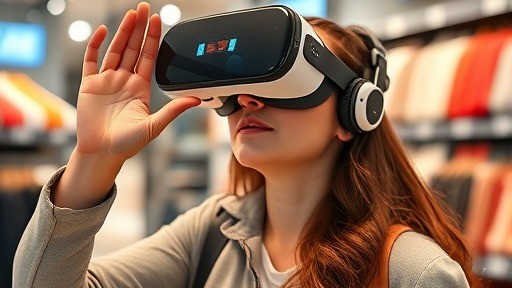Augmented Reality (AR) and Virtual Reality (VR) often conjure images of futuristic gaming or niche entertainment experiences. However, as we navigate 2025, these immersive technologies are rapidly maturing and moving firmly into the business world, offering tangible solutions to real operational challenges and creating innovative ways to connect with customers.
While widespread adoption is still evolving, the potential is undeniable. Businesses across the UAE, known for its embrace of cutting-edge technology and focus on exceptional experiences, are increasingly exploring how AR and VR can drive efficiency, improve skills, and create competitive advantages. But beyond the initial "wow" factor, what are the practical applications delivering value today?
Let's demystify these technologies and explore their journey from powerful internal tools to transformative customer-facing applications.
Quick Definitions: AR vs. VR in a Business Context
It's crucial to understand the distinction:
- Virtual Reality (VR): Creates fully immersive, computer-generated environments that completely replace the user's real-world surroundings. Typically requires wearing a headset (like Meta Quest, HTC Vive, etc.). Think: Stepping into a different world for training, design reviews, or virtual tours.
- Augmented Reality (AR): Overlays digital information, graphics, or objects onto the user's view of the real world. Often accessed via smartphones, tablets, or increasingly, specialized smart glasses. Think: Seeing assembly instructions overlaid on machinery, placing virtual furniture in your actual living room, or accessing information by pointing your phone at an object.
They address different needs, but both offer unique ways to interact with digital information and simulations.
Internal Applications: Optimizing Operations & Skills (VR Focus)
VR's immersive nature makes it particularly powerful for internal applications:
-
Revolutionizing Training & Skill Development:
- Use Case: Training employees on complex or dangerous procedures without real-world risk – think surgeons practicing complex operations, engineers learning to operate heavy machinery, technicians handling hazardous materials, or emergency responders simulating crisis scenarios. It's also effective for standardized onboarding (virtual facility tours) and practicing soft skills through realistic role-playing simulations.
- Benefits: Significantly improved safety, reduced costs (less material waste, travel, equipment damage), accelerated learning curves, higher knowledge retention rates compared to traditional methods, and consistent training delivery across the workforce. This is highly relevant for key UAE sectors like construction, aviation, healthcare, energy, and logistics.
-
Enhancing Design, Collaboration & Prototyping:
- Use Case: Architects, engineers, and product designers collaborating on intricate 3D models within a shared virtual space, regardless of their physical location. They can manipulate designs, identify flaws, and iterate much faster than with 2D drawings or physical mock-ups.
- Benefits: Faster design cycles, reduced need for costly physical prototypes, improved understanding and communication among team members, and seamless remote collaboration for globally distributed teams often connected via hubs like the UAE.
External Applications: Engaging Customers & Boosting Sales (AR Focus)
AR excels at blending the digital and physical worlds, opening exciting avenues for customer interaction:
-
Interactive Product Visualization & Virtual Try-Ons:
- Use Case: Allowing customers to use their smartphone camera to place a virtual sofa in their living room to see how it fits and matches decor, virtually try on clothing or cosmetics, or explore complex products (like cars or appliances) in 3D from the comfort of their home.
- Benefits: Significantly increased customer engagement and confidence, higher online conversion rates, reduced product return rates (as customers make more informed choices), and bridging the gap between online and physical retail experiences – vital for the UAE's thriving retail landscape.
-
AR-Enhanced Marketing & Brand Experiences:
- Use Case: Creating interactive print advertisements that trigger 3D models or videos when scanned, developing location-based AR experiences for tourists or event attendees, or designing product packaging that reveals additional information or animations through an AR app.
- Benefits: Creates memorable, engaging marketing campaigns that cut through the noise, offers innovative ways to tell brand stories, increases dwell time, and provides unique experiences highly valued in sectors like tourism, events, and real estate within the UAE.
-
Improving Field Service & Remote Assistance:
- Use Case: Enabling experienced technicians to remotely guide less experienced field staff through complex repairs or maintenance tasks. Using AR smart glasses or tablets, the remote expert can see what the field worker sees and overlay instructions, diagrams, or highlight specific components directly onto their view.
- Benefits: Faster diagnosis and resolution times, reduced travel costs for experts, improved first-time fix rates, effective knowledge transfer, and increased operational efficiency, particularly valuable in maintenance-heavy industries.
The State of Play & UAE Context (April 2025)
AR and VR technology continues to improve. Headsets are becoming lighter and more affordable, mobile AR capabilities (on smartphones) are increasingly sophisticated, and development platforms are making content creation more accessible. While challenges like content development costs and ensuring user comfort remain, the trajectory is clear.
The UAE, with its strong digital infrastructure (including 5G), government support for innovation (e.g., initiatives supporting AI and immersive tech), and key sectors like retail, real estate, tourism, logistics, and energy, provides fertile ground for both experimentation and practical deployment of AR/VR solutions.
Considerations for Implementation
Thinking of exploring AR/VR?
- Start with the Problem: Identify specific business challenges or opportunities where immersive tech offers a unique advantage, don't just chase the technology.
- Focus on ROI: Define clear objectives and metrics to measure success for pilot projects.
- Content is Key: High-quality, relevant AR/VR content is crucial for effectiveness; factor in creation costs and expertise.
- User Experience: Consider hardware usability, user comfort, and necessary training for adoption.
Conclusion: Immersive Tech is Getting Down to Business
AR and VR are transitioning from futuristic concepts to practical business tools. Whether it's creating safer, more effective training environments with VR or engaging customers in entirely new ways with AR, these immersive technologies offer significant potential. As hardware improves and development becomes easier, we can expect AR and VR to become increasingly integrated into standard business processes and customer journeys, providing tangible value far beyond the initial novelty. For businesses in the UAE looking to innovate and optimize, now is the time to seriously explore where AR and VR can make a strategic difference.
Curious about how Augmented or Virtual Reality could specifically benefit your business operations or customer engagement strategies? Dehongi helps organizations navigate emerging technologies and implement solutions that drive real value. Contact us for an exploratory discussion.

